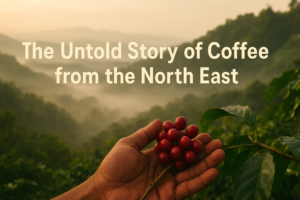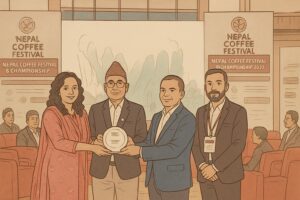
A Colonial Legacy Brewed in the Hills
Long before the world knew Sri Lanka for its iconic Ceylon Tea, the island was one of the world’s leading coffee producers. Introduced under British colonial rule in the early 1800s, coffee plantations flourished in the central highlands — particularly in Kandy, Nuwara Eliya, and Badulla. By the 1870s, Sri Lanka (then Ceylon) ranked as the third-largest coffee producer globally, trailing only Brazil and the Dutch East Indies.
But this golden brew era was short-lived.
The Great Coffee Collapse: Enter the Rust
In 1869, disaster struck. A fungal disease known as coffee leaf rust (Hemileia vastatrix) began to ravage plantations across the island. Within two decades, more than 90% of Sri Lanka’s coffee production was decimated. British planters, facing ruin, swiftly shifted focus to tea — giving birth to the now-legendary Ceylon Tea industry.
The once-booming coffee sector faded into obscurity, becoming a forgotten chapter in Sri Lanka’s agricultural legacy.
The Quiet Revival: A New Coffee Generation
Fast forward to the 21st century — Sri Lanka is witnessing a coffee renaissance, not through industrial-scale plantations, but through artisanal, small-batch, and specialty farming.
🔁 What’s fueling this revival?
- Rising global demand for specialty coffee
- A new wave of urban café culture among Millennials & Gen Z
- Support from sustainable farming cooperatives
- A growing sense of cultural nostalgia and agritourism
Where It Grows: Modern Coffee Regions
Today, Sri Lankan coffee thrives in highland regions that offer shade-grown, rain-fed conditions — ideal for cultivating quality Arabica.
Key Growing Areas:
- Uva Province (Badulla, Bandarawela)
- Central Province (Kandy, Matale)
- Sabaragamuwa & Nuwara Eliya (high-altitude zones)
Coffee is predominantly grown by smallholder farmers, often alongside pepper, cardamom, and areca nut, promoting biodiversity and resilience.
📊 Coffee Production at a Glance
| Metric | Approximate Figure |
| Total Annual Output | ~400–500 metric tons |
| Key Varieties | Arabica (some Robusta) |
| Elevation | 800–1200+ meters |
| Main Export Markets | EU, Japan, USA (niche roasters) |
| Domestic Use | Rapidly increasing |
While it may not rival tea in volume or export revenue, Sri Lankan coffee is carving a boutique identity — rich in flavor, history, and purpose.
Consumption Patterns: Urban Cafés & Conscious Sipping
In cities like Colombo, Kandy, and Galle, a dynamic coffee scene is emerging. Specialty cafés are not just places to drink coffee — they’re hubs for storytelling, experimentation, and community.
Noteworthy Cafés:
- Soul Coffee (Colombo) – Emphasizing origin-led storytelling
- Kopi Kade – Blending local flavors with global trends
- Whight & Co. – Among the pioneers of specialty roasting in Sri Lanka
What today’s consumers love:
- Single-origin brews
- Sustainably sourced beans
- Cold brews, signature blends & brewtails
- Coffee festivals and barista events
Challenges to Overcome
Despite the growth, challenges remain:
- Lack of processing and export infrastructure
- Low local awareness of specialty coffee
- Dominance of the tea industry
- Shortage of trained baristas, roasters, and cuppers
But the momentum is building, with NGOs, private sector efforts, and international collaborations stepping in to build capacity and knowledge.
The Indian Connection
Sri Lanka’s coffee heritage is deeply intertwined with South India — especially regions like Chikmagalur, Coorg, and Wayanad.
- During colonial times, planters and traders moved freely between the two regions.
- South Indian filter coffee influences can still be seen in Tamil Sri Lankan households.
- There’s strong potential for India–Sri Lanka collaborations in coffee trade, storytelling, and experiential tourism.
What’s Brewing Next?
Sri Lanka’s coffee story isn’t about scale — it’s about soul. The revival is rooted in:
- Sustainability over speed
- Craft over commodity
- Culture over commercialism
As café culture deepens and agro-tourism gains popularity, Sri Lankan coffee is reclaiming its place — not as a competitor to tea, but as a symbol of revival, resilience, and ritual.
Final Sip
In Sri Lanka, coffee is more than a drink.
It’s a forgotten history rediscovered — in farms, in cafés, and in conversations.
And perhaps, that’s what makes every cup so special.
In Sri Lanka, coffee is more than a drink.
It’s a forgotten history rediscovered — in farms, in cafés, and in conversations.
And perhaps, that’s what makes every cup so special.
Have you ever experienced Sri Lankan coffee or its café culture?
Share your thoughts or stories in the comments below — we’d love to hear them!






Nice to know Sri Lanka’s coffee is back. Would like to visit some farms there and of course taste their coffee.
Nuwara Eliya would be ideal for growing arabicas like bourbon and geishas.
Yes, it’s exciting to see Sri Lanka reclaim its coffee roots. Visiting farms in Nuwara Eliya would be great — the climate and altitude truly make it ideal for high-quality Arabicas like Bourbon and Geisha. I’ll be sharing more about coffee trails and producer stories soon – stay tuned.
Loved this deep dive into Sri Lanka’s coffee history! The blend of colonial legacy and modern revival is so fascinating. Are there any coffee villages or trails you’d recommend for travelers?
Thank you so much! I’m so glad you enjoyed the piece — Sri Lanka’s coffee journey really is a beautiful blend of past and present. For travelers, I’d highly recommend exploring Ragala (where Hansa Coffee operates) and Nuwara Eliya, which has the perfect climate for Arabicas. Also, keep an eye on Temple Grounds and Soul Coffee, as they often collaborate with local farms. Hoping to map out a full “Ceylon Coffee Trail” soon — stay tuned!
So good to know Sri Lanka is growing great coffee again! Would love to try a local brew someday — any cafes or roasters you’d recommend?
You may try Café Kumbuk, Department of Coffee, Soul Coffee Company, The Beans Coffee Factory, Hansa Coffee. Do follow @curlybreww for more updates.